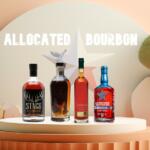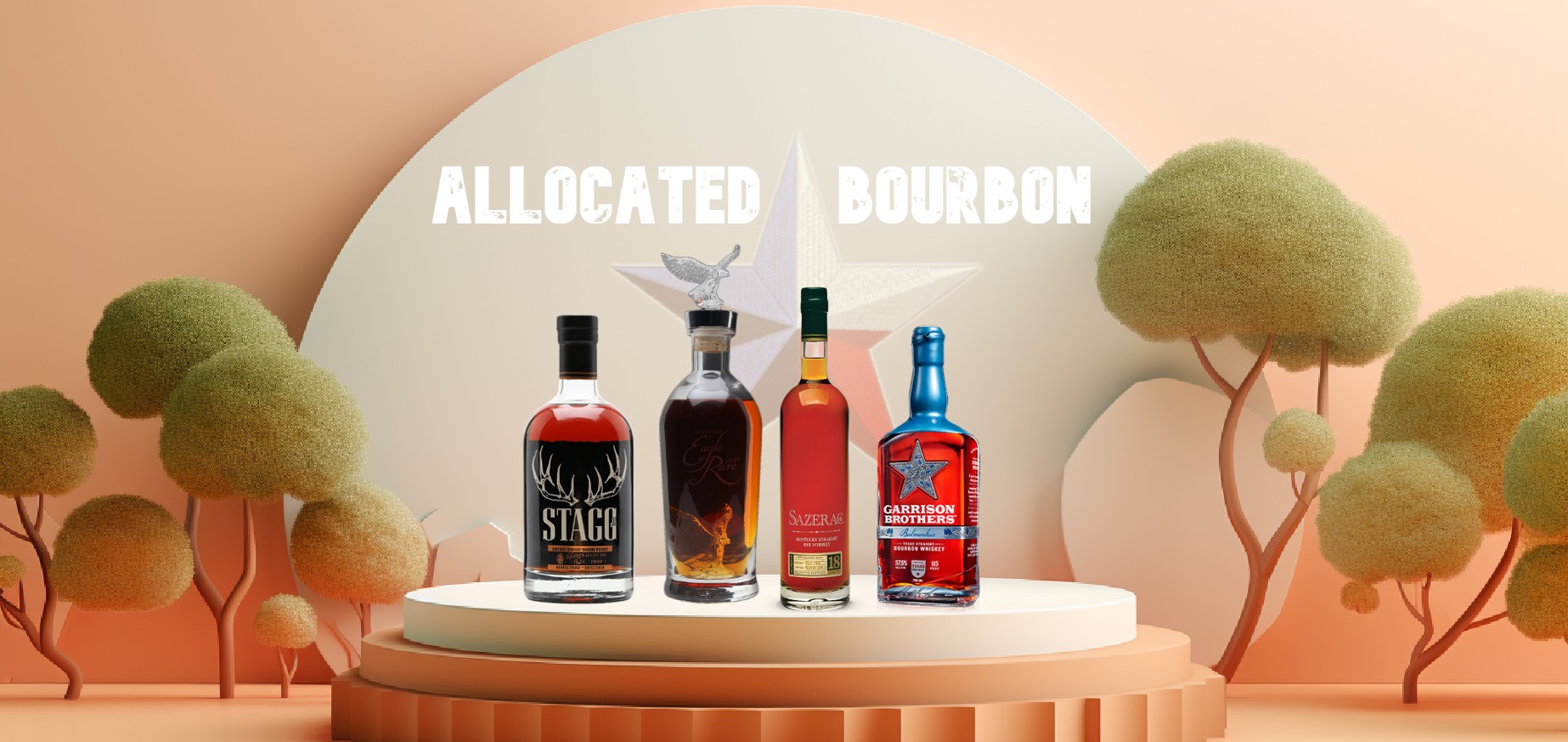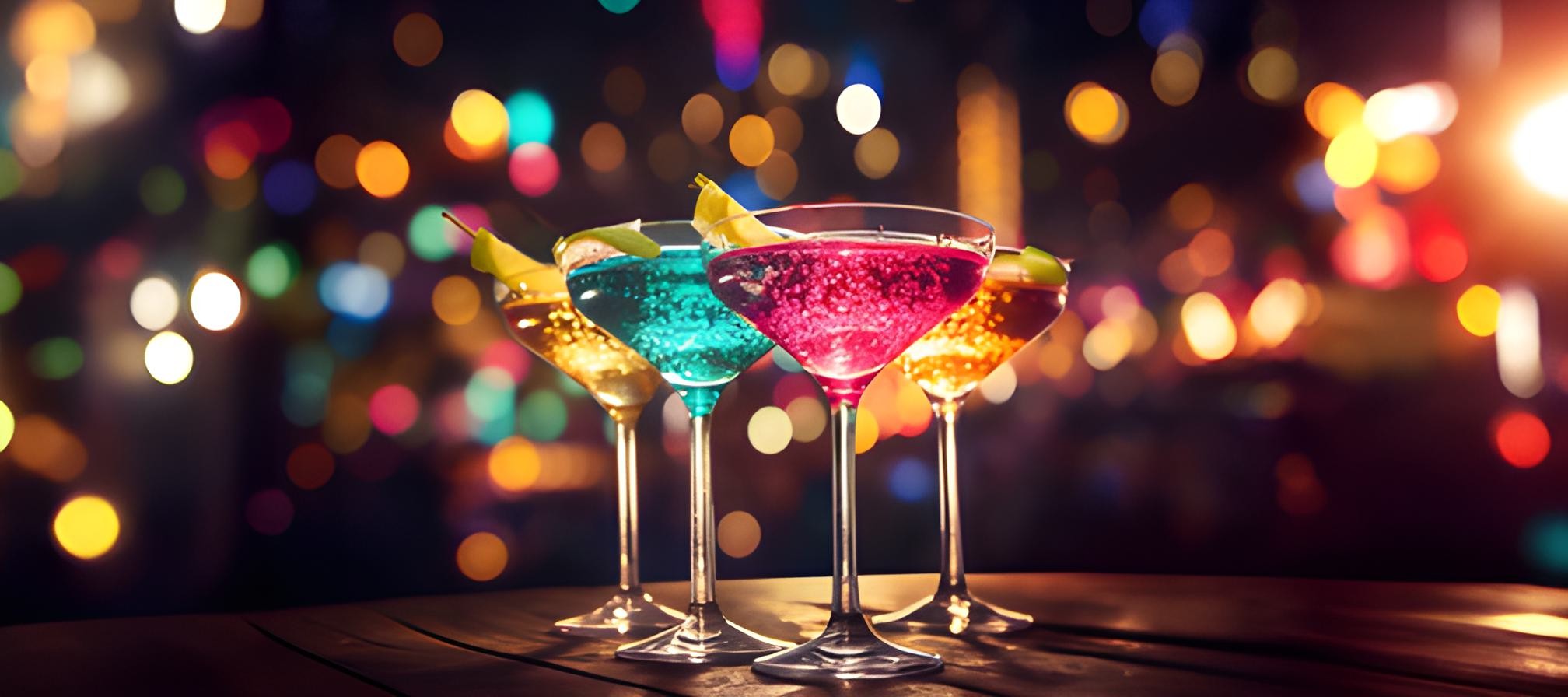You walk into the liquor store, stroll around the aisles, and pick up a few different types of liquor bottles to read the labels before putting them back and grabbing “that one bottle” you know you like. Or maybe you walk up to the bar and stare at the different types of liquor bottles for a solid minute before asking the bartender for a recommendation. Do either of these situations sound familiar? If so, you need to read our complete guide to the different types of liquor.
The truth is that the world of liquor is enormous and nuanced, and it can be daunting to explore at first—it can become expensive to research, too, adding even more to the sense of unease. Getting a good lay of the land of liquor (and all the quirks and nuances of the different types of liquor) is fundamental in moving past the “uncomfortable” to a place where you feel confident walking into the drinks store.
Lucky for you, we’re here to give you exactly the rundown you need. Here are some of the most common and popular different types of liquor—and what you need to know about each of them.
What is Liquor?
First things first—what are we talking about when we say “liquor?” It doesn’t seem unreasonable at first to think of a bottle of liquor as any bottle with an alcoholic beverage inside of it, but this isn’t exactly right. Beer and wine, for example, are not considered to be different types of liquor. This is because there’s a difference between what we call fermentation and distillation.
Fermentation is the process of turning sugars into alcohol. Beer, wine, and even ciders are examples of beverages that have undergone the fermentation process. You might notice that these are all alcoholic beverages that are relatively low in alcohol percentages, and conveniently, that’s one of the important differences between the two processes.
Distillation takes a fermented beverage and cranks it up a few notches. This is done by separating the water from the rest of the alcoholic mixture to remove the water altogether. This, of course, leaves you with a much stronger, much more concentrated alcoholic drink than before. This distillation process is what gives us liquor, playfully referred to as “the hard stuff.”
Okay, so liquor is a distilled alcoholic beverage. That’s great to know, but it still isn’t that specific. This definition still encompasses hundreds of bottles in the spirit store and pretty much every bottle behind the bartender.
To better understand some of the nuances that go with making liquor, it’s important to know the differences between the different types of liquor:
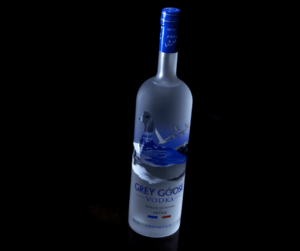
Vodka
This is the inoffensive spirit that lives in infamy for one reason in particular: vodka is a neutral spirit. A standard vodka should not have a distinctive color, smell, or even a distinctive taste. This leads a lot of people to think that it’s a pretty tame liquor, but those same people are wrong every time.
You might have heard that vodka is made from potatoes, but vodka isn’t only a potato-based beverage. Potatoes are often used, but grains like rye or wheat and even fruit are used, too. The materials of choice are cooked in filtered water, then the mixture is heated to produce sugar from these starchy pieces of produce. We call this the mash.
These sugars must then be fermented into alcohol, and this is done with yeast. And once the fermentation is complete, the yeast has to be separated from the rest of the mixture. This is done during the distillation process.
Vodka must go through this distillation process at least three times, and many vodkas go through it many times more. The distilled product must then go through a filtering process. Vodkas are filtered through natural substances, such as charcoal, to get rid of any impurities in the spirit.
What you’re left with is the classic, clear spirit that is ubiquitous in beverages around the globe. And while there is no universal taste of vodka, that isn’t to say vodka is completely odorless and flavorless. Bring a glass up to your nose with your mouth open and try to take in the subtle notes on the nose, because a well-made vodka will have them. In the same way, taking a sip and letting the vodka coat your tongue will help you pick up any subtle notes hidden in that particular spirit. Adding a drop of water can help open up these hidden treasures, too.
Enjoy your vodka chilled, on the rocks, or in a cocktail. A vodka martini is an indisputable classic. At Zipps, we sell a wide variety of Vodka brands, such as Grey Goose, Tito’s, Skyy, and Heaven Hill. Pick up a bottle at your local Zipps Liquor for the best price around! View all our vodka brands.
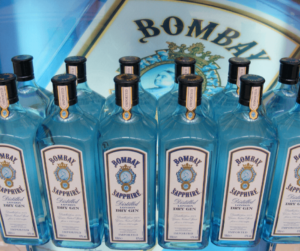
Gin
Far from just a prop in The Great Gatsby, gin is a refreshing and delicious liquor that has been present in generations of popular culture in both European and American history.
The relationship between gin and vodka is actually quite close. Taking that same starchy substance, the mash, and distilling it with botanicals is how we arrive at gin. In a sense, one could say that gin is vodka with an extra step, just maybe don’t say that too loudly.
There are loads of different ways to make gin, too, many of which have been popular throughout its long history. Recently, the number of popular ways to produce gin has decreased. Pot distilling, column distilling, and compounding are some of the most popular methods used still today.
Gins fall into just a few different categories. Juniper Gin is made by fermenting a grain mash, letting it reach a pretty robust strength (a bit under 70% ABV normally), before redistilling with botanicals. As the name would suggest, the main aromatic remaining present is juniper. Distilled Gin is produced by redistilling ethyl alcohol that is much stronger than standard fermented mash (about 96% ABV). Only after that is it introduced to the botanicals, primarily juniper.
The most common and popular kind of gin, however, is London Dry Gin. This, too, is made with ethyl alcohol, this time 100% ABV with a methanol content of 5g per hl. The sweetness is very limited; in order to fit into the London Dry Gin category, there should be no more than .1 grams of added sweetness per liter of the liquor, and it also cannot contain any coloring or additional ingredients beyond plain water.
Gin is famously enjoyable in cocktails like the martini and the gin and tonic. It’s also great to drink on its own or on the rocks, and maybe even with a bottle of vermouth nearby. Check out our favorite Gin Recipes.
At Zipps, we have a wide variety of Gin Brands to choose from, such as Bombay Sapphire London Dry Gin, Mccormick’s, and Heaven Hill. View our brands list.
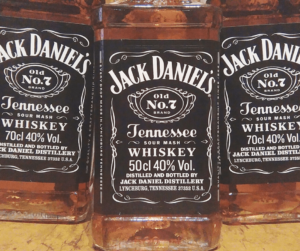
Whisk(e)y
If the world of liquor is vast and confusing, the world of whiskey in and of itself is just as vast and maybe more confusing. The many different kinds of whiskey can leave you confused, and even the bifurcated spelling can leave you scratching your head.
That confusing “e” is more of a bother than it really needs to be. As a somewhat iffy rule of thumb, a whisky coming out of Scotland, Japan, or Canada is spelled with no e, and a whiskey made in the U.S. or in Ireland includes the e. That said, there are brands that break this rule back and forth, so it’s really not too big a deal if you prefer one spelling over the other.
Now, let’s break down the different types of whiskey that you’re bound to encounter. These are all types of whiskey, but have pretty distinctive (and surprising) details that set them apart.
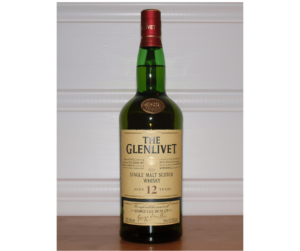
Scotch
Scotch Whiskey, to nobody’s surprise, comes out of Scotland. It’s also aged for at least three years in oak barrels to qualify as scotch. Unlike vodka, modern scotches are normally distilled only twice, and they can be classified in the following categories:
- Single malt is a term that refers to scotch produced from a single distillery and only from malted barley.
- Single grain is similar; it refers, again, to scotch that is produced from a single distillery, but also has some different grains in the mash besides only the malt.
- Blended malt is a blend of multiple different single malt scotches made from different distilleries; these whiskeys don’t come from a single specific distillery.
- Blended grain, similarly, is a blend of multiple different single grain scotches from different distilleries.
- Blended scotch is a blend of one or more single malt scotches along with one or more single grain scotches.
For some folks, blends might sound a little taboo, but the vast majority of scotch is actually blended scotch—and that includes some of the best in the world.
Irish Whiskey
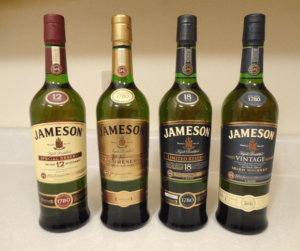
Just as unsurprisingly, Irish whiskey must come from Ireland. Another difference in the production process is that Irish whiskey is distilled three times, but this whiskey is also aged at least three years in oak barrels.
The classification system that goes with Irish whiskey is not as strict as that of scotch; blended and unblended Irish whiskeys are what make up the market, that simple. A blended Irish whiskey is any Irish whiskey that includes at least two separately produced whiskeys.
One characteristic difference between Irish and Scotch whiskeys is that Irish whiskeys tend to be a bit more aggressive and have a bit more of a spicy bite. Jameson is a classic example of an Irish whiskey that showcases this forward aggression that Scotch whiskeys often do not have.
American Whiskey
If we want to get into categories within categories within categories, American whiskey is the place to look. Big-screen stories and blues walking charts might have convinced us that bourbon is the one and only bottle to reach for at the local bar (and many bourbon enthusiasts would champion that notion), but truth is that there’s a very diverse variety of whiskey to be explored within the borders of American whiskey.
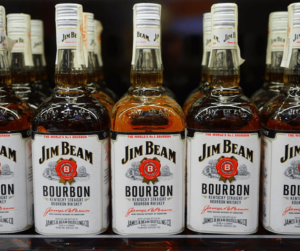
Bourbon, of course, is an important part of this family. In order for a whiskey to be considered bourbon, it must be made in the United States. It must also be made from a grain mixture that is at least 51% corn. It must be aged in new charred oak containers, be distilled to no more than 80% ABV, entered into the container for aging at no more than 62.5% ABV, and bottled at no less than 40% ABV. A bottle of bourbon should be labeled straight if has been aged a minimum of 2 years. While there aren’t rules and regulations on flavor profile, bourbon is typically characterized by its notes of vanilla, caramel, oak, and spices. Learn how to make Cocktails with Bourbon.
Rye is a close second when it comes to iconic whiskey lyrics in classic American tunes. Similar to bourbon, rye whiskey must be made with grain that is at least 51% rye and aged in charred, new oak barrels. Rye whiskeys tend to be less on the sweet, dessert-style side of whiskey and a bit more aggressive, a bit spicier, and often a bit more challenging to sip.
Tennessee whiskey is another branch of American whiskey. Describing Tennessee whiskey at this point is pretty straightforward, since the requirements are that the whiskey meet the requirements of bourbon while also being produced in the state of Tennessee. Tennessee whiskey also undergoes a charcoal purification process called the Lincoln Country Process, which gives Tennessee whiskey additional charcoal notes on top of the other classic bourbon flavors.
American whiskeys are often enjoyed straight or on the rocks. There are some classic cocktails that take these spirits well, however. A Sazerac and a whiskey sour are two wonderful examples.
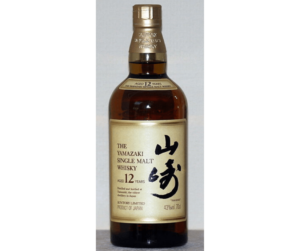
Japanese Whiskey
This whiskey is by no means new, but is certainly a branch that has recently been brought into the spotlight. Japanese whiskey is made largely in the same style as scotch with a few deviations. These whiskeys are very smooth, with light sherry and floral notes, sometimes even smoky and peaty.
We have a wide variety of whiskey brands of all types from all over the world at Zipps. Some of our bottles we have in stock include Chivas Regal, Glenlivet, Jack Daniels, Crown Royal, Southern Comfort, and Jim Beam. View all of our Whisky brands in stock.
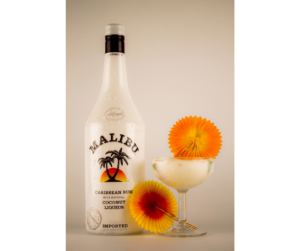
Rum
Interestingly enough, while rum is the most commonly purchased spirit in the United States, it’s also a bit of an underdog when it comes to reputation. Rum is sold more than any other spirit, but it’s rarely considered “premium” on any menu. There are, however, some incredible rums out there to sip.
Rum is made from sugarcane that is distilled from either the raw sugarcane juice or from molasses, the latter of which is more common. Light rums are bottled immediately after the distillation process, and some rums are aged in in barrels (these are the darker rums).
There aren’t many hard-set rules on different categories of rum, especially if we compare it to the rigor that classifies different whiskeys. Here, there are simply light rums, dark rums, rums that are well spiced, rums that do or don’t fall more on the sweet side, and rums that fall somewhere in between. This makes for a wide variety of different types of liquor bottles to explore. Taste different bottles over time to know which sugar cane spirits you’ll prefer in your daiquiri and which you’ll prefer on the rocks!
At Zipps, we carry a large variety of Rum brands such as Bacardi, Captain Morgan, and Malibu.
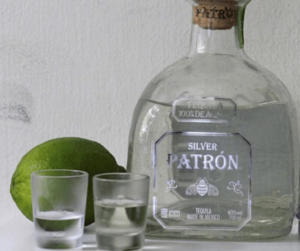
Tequila
This is a spirit that garners a love/hate relationship with some folks who have gotten to know it, perhaps more than other liquors. You might say this has happened due to a commercialized affinity for tequila shots instead of taking some time to really enjoy the spirit for what it is. That’s not to say that shots should be written off completely, to each their own, but there is more to know about tequila than what a blurry night and a nasty hangover have to offer.
Tequila has a rich history dating back to Aztec traditions. This traditional Aztec drink took the form of a thicker, milkier alcoholic beverage called pulque, still famous and consumed in Mexico today. Both tequila and pulque come from the blue agave plant, which must be cooked, fermented and then distilled before obtaining that bottle of tequila we all love (or fear).
Tequila bottled immediately after distillation is called blanco. If it’s aged for 2-12 months in oak barrels, it’s called reposado. A blend between these two kinds of tequila is called joven. Añejo is a term reserved for tequilas aged 1-3 years in oak barrels, and mixto refers to tequila containing less than 100% blue agave, often containing sugars or even other spirits.
Try taking your tequila straight and slow next time, and see if you can catch those blue agave notes that have been around since ancient civilizations. If you’d prefer to try it in a cocktail, learn how to make some of our favorite cocktails with tequila.
We’d be amiss to touch on tequila and not mention mezcal in an article exploring liquors. Mezcal is a spirit closely related to tequila, and in some ways even more intimately connected to Mexican culture. The production process is similar to tequila, although much less industrial, only deviating in a few details. A big distinction to be made is that, if tequila is hard to sip, mezcal is going to give you a really tough time. Most of the time, mezcal is much more aggressive, and certainly a much more challenging liquor to drink.
Mezcal is traditionally enjoyed straight along with some orange slices, chapulines, and sal de gusano. The crickets and ground worm salt certainly aren’t obligatory if you’re only just inching into this culture.
At Zipps, we have a wide variety of Tequila brands, including Mezcal as well. Our top brands include Patron Tequila, El Jimador, and More. View all of our Tequila brands in stock.
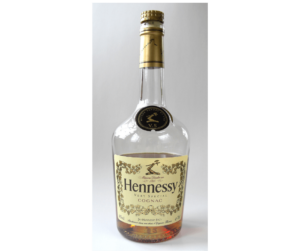
Brandy
Mezcal and tequila are related in much the same way that cognac and brandy are. But wait—didn’t we say that wines are not considered liquors? Well, yes. This does not mean, however, that wines cannot become liquors. In fact, that’s precisely how we come across brandy.
Brandy is made by distilling wine or other fermented fruit beverages. It doesn’t have to be aged, but if it is, chances are it’ll be called cognac. This is because cognac is simply aged brandy (produced in a specific region of France) that follows a few other additional requirements.
Most of the time, brandies and cognacs are enjoyed straight. There are cocktails such as the sidecar or the vieux carré that incorporate cognac, specifically. We carry a wide variety of Brandy and Cognac brands at Zipps, including Hennessy and Presidente Brandy. View all of our Brandy and Cognac brands in stock.
In this ultimate guide, we’ve covered some of the most popular and well known different types of liquors. These are the ones you’ll want to start exploring to gain your confidence in vast world of spirits. This list isn’t comprehensive, of course, and it would be impossible to make such a list! Since liquor is “any distilled alcoholic beverage,” there is always room for a new and different type of liquor to be made, enjoyed, and categorized. Rather than seeing this endless list as daunting, we invite you to see it as an endless world of culture and wonderful drinks to enjoy.



